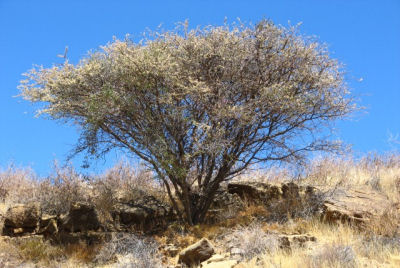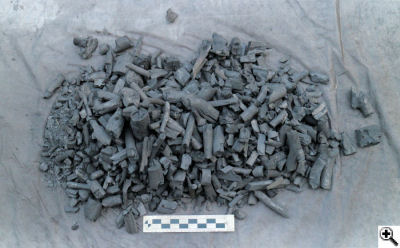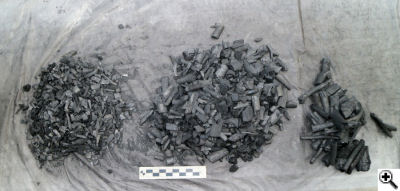This is another brand of charcoal that we discovered on Facebook in one of those "Anybody tried this?" threads. While
the brand of charcoal is new to us,
the type of wood it is made from is not.
We recently reviewed JURK charcoal which is made from a species of Acacia that
comes from Brazil. This new charcoal from The Good Charcoal Company comes from a species of Acacia (Senegalia mellifera)
that grows in Namibia. And according to the manufacturer,
"...the
overgrowth of the Acacia through “bush encroachment” threatens open grasslands needed for people and wildlife alike.
In fact, bush encroachment is also endangering the cheetahs in Namibia that need these grasslands to hunt."
thus making it a good candidate for making charcoal. Further, the
Forest Stewardship Council says that charcoal made in Namibia from Acacia wood:
"...is known to be among the most ecologically produced charcoal in the world. No deforestation is involved.
On the contrary, harvesting the encroaching bushes and trees helps restore the original ecological values of
the soil. Clearing also helps wild animals roam freely in the veld and prevents fires. Jobs are created and
the environment is preserved."
It's other uses include tannin for the production of soft leather, resins, thinners and adhesives,
the timber for building materials,

Namibian Black-thorn (Senegalia mellifera)
|
and the pulp and wood chips are used to produce paper. We provide for your enlightenment, a map showing
the location of Namibia above right. And to the right, we provide a photo of an acacia tree.
But enough about acacia. Let's see what Acacia wood charcoal is like and how it performs.
As usual, our first step is to dump the bag out onto the ground and sort it into small, medium and large pieces, as well as
the chips and dust at the bottom of the bag. We also look for scrap, uncarbonized wood, and other interesting objects.
What a disappointing surprise! The entire bag was composed of small (1" to 2" pieces) and chips/dust. We opened a second
bag, and it was the same. (We have also seen photos on Facebook of bags the look exactly like ours.) You expect to find the large pieces on top and the smaller pieces towards the bottom, but
there simply were no large pieces in the bag. The top of the bag was exactly the same as the bottom.
(And before the "it was mishandled by jack-booted thugs" crowd gets going, let us say that it was quite clear that this is not
the result of mishandling. If a bag of charcoal has been mishandled, there will be tell-tale signs, and there were none.
How we received the charcoal is more or less how the charcoal looked when it was bagged.)
We found no scrap, but we did find a number of plastic strips in the charcoal. Charcoal is typically bagged in large white
bags made of woven plastic strips, much like the blue tarps you see in the hardware stores. It is shipped in bulk in these
white plastic bags and then bagged in retail packaging at some other location. The Good Charcoal Company is allowing too much
of this plastic to end up in their bags. If you do plan to use this charcoal, you would do well to sort through the bag
and remove any plastic you find.
Since the entire bag consisted of small pieces, there wasn't much to sort, but here's the result of separating out the
small pieces from the chips and dust:
| Large |
0.0 pounds |
0.0% |
| Medium |
0.0 pounds |
0.0% |
| Small |
12.5 pounds |
80.1% |
| Chips/Dust |
3.0 pounds |
19.9% |
|
|
|
| Total |
15.5 pounds |
|
|
So, as you can see, nearly 20% of the bag was unusable chips and dust, which is High ( )
compared to all other brands tested. The total weight of the charcoal was right at what was advertised.
)
compared to all other brands tested. The total weight of the charcoal was right at what was advertised.
Things seemed to look up when we conducted our lighting test. It only took 3 sheets of newspaper in
a standard chimney starter to get this charcoal burning. This is Low ( ) compared to all other brands.
There was no sparking or popping at all, and the smell of the igniting charcoal was a fairly strong
tropical wood smell.
) compared to all other brands.
There was no sparking or popping at all, and the smell of the igniting charcoal was a fairly strong
tropical wood smell.
So, on to the maximum temperature test. The Good Charcoal Company charcoal burned at 868°F, which just
barely squeaks into the High ( ) category. We have to think it might have burned a bit hotter if the charcoal
was composed of larger pieces that would allow greater airflow. In any event, while burning there were no
sparks or pops.
) category. We have to think it might have burned a bit hotter if the charcoal
was composed of larger pieces that would allow greater airflow. In any event, while burning there were no
sparks or pops.
Next comes our burn time test. The burn time for this charcoal was Low ( ) compared
to all other brands. There were virtually no pops or sparks when lighting with a MAP/Pro torch except for one big pop which
took us by surprise. In any event, always take appropriate precautions whenever lighting lump charcoal with any kind of torch.
) compared
to all other brands. There were virtually no pops or sparks when lighting with a MAP/Pro torch except for one big pop which
took us by surprise. In any event, always take appropriate precautions whenever lighting lump charcoal with any kind of torch.
Finally, we come to the ash production test. What word should we use to describe the amount of ash produced by this charcoal?
Huge? Monstrous? Stunnig? Prodigious? Well, it was a whole lot. It was Very High ( ) compared to
all other brands. In fact, it was the second highest amount of ash produced by any lump charcoal we have ever tested. Another
indication of how much ash was produced is that it completely blocked the air pathway in the bottom of our small Big Green Egg
cooker. The only reason the fire didn't go out was because we use a blower-based temperature controller to conduct the test and
the blower was able to force air into the fire.
) compared to
all other brands. In fact, it was the second highest amount of ash produced by any lump charcoal we have ever tested. Another
indication of how much ash was produced is that it completely blocked the air pathway in the bottom of our small Big Green Egg
cooker. The only reason the fire didn't go out was because we use a blower-based temperature controller to conduct the test and
the blower was able to force air into the fire.
So, what rating to give this charcoal? The negatives are the amount of plastic waste we found, the unbelievable amount of ash it
produces, the miserable size distribution and the very low burn time. The only positives were that it was easy to light and it did
manage to burn relatively hot. We are inclined to give it our Not Recommended rating. The only thing that saves it
from that fate is that up to this point, we have only used Not Recommended for brands sold by fraudsters.
So, while their environmental impact is laudable, what they are to doing to help the cheetahs in Namibia is laudable and what
they are doing to help local US communities is laudable, when rating a charcoal we have to look at how it compares with all
other brands. And in this case, based on the performance indicators, it gets our Below Average rating.
|
Update (08/21/22):
After publishing our review we heard from a few of the folks who believe in
the old wive's tale that bad bags of charcoal like the bag we reviewed here are caused by jack-booted Wal*Mart
thugs who stomp on each individual bag 10 times before loading it on the shelf. So therefore, in their minds our review is
ridiculous because we just happened to get a "bad bag." Well we personally believe that
the lump you pour out of your bag is, for the most part, pretty much in the same condition that it was in when the
manufacturer put it into the bag. We have received dozens and dozens of bags shipped from around the world
via different carriers that have arrived in fantastic condition. We just don't buy it.
That said, we thought we would placate these critics and give The Good Charcoal Company a second chance by
opening a second bag for sorting. We obtained a second bag from a different source and here are the photos
of the charcoal straight out of the bag and then after sorting:


Not a whole lot of difference. In this second bag there were still no large pieces.
The medium pieces only made up 19.3% of the bag. Over 80% of the bag consisted of small
pieces and chips and dust. This does nothing to change our minds and we are leaving our
rating at Below Average.
|

